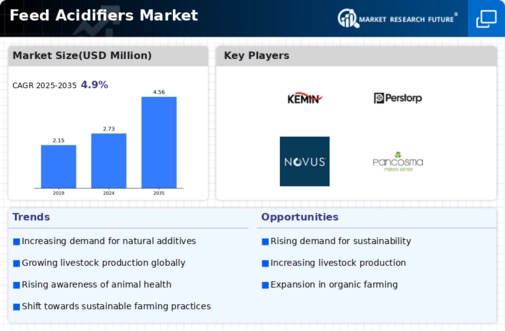Market Share
Feed Acidifiers Market Share Analysis
Market factors play a crucial role in determining the size and dynamics of the in-feed acidifiers market. These factors encompass a wide range of elements that influence demand, supply, pricing, and overall growth within the industry. One of the primary market factors driving the size of the in-feed acidifiers market is the increasing demand for animal protein products. As the global population continues to grow, so does the demand for meat, dairy, and other animal-derived products. In-feed acidifiers are used in animal feed to promote growth, improve feed efficiency, and maintain animal health, making them essential in meeting the rising demand for animal protein. A significant challenge for this industry is the elevated cost associated with feed acidifiers. This poses a barrier for many small-scale farmers operating family-owned farms who may find these acidifiers financially out of reach. Consequently, only larger corporate farms will likely have the financial capacity to procure these acidifiers, thus impeding the market's growth rate in terms of both size and pace for an extended period. Additionally, concerns regarding animal health and food safety contribute significantly to the growth of the in-feed acidifiers market. Consumers are becoming more conscious of the quality and safety of the food they consume, leading to a greater emphasis on animal welfare and the reduction of antibiotic use in animal production. In-feed acidifiers offer a natural alternative to antibiotics, helping to maintain animal health and mitigate the risk of diseases, thereby aligning with the growing consumer demand for safer and healthier food products.
Moreover, regulatory policies and guidelines play a pivotal role in shaping the in-feed acidifiers market landscape. Government regulations pertaining to the use of antibiotics in animal feed, as well as stringent food safety standards, drive the adoption of in-feed acidifiers as a sustainable and regulatory-compliant solution. Manufacturers and suppliers in the in-feed acidifiers market must adhere to these regulations and ensure compliance with quality and safety standards, thereby influencing market size and competitiveness.
Furthermore, advancements in feed technology and research contribute to the expansion of the in-feed acidifiers market. Ongoing research and development activities aim to improve the efficacy and efficiency of in-feed acidifiers, leading to the introduction of innovative products with enhanced functionalities. Technological advancements also enable manufacturers to develop customized solutions tailored to specific livestock species and production systems, catering to the diverse needs of the global animal agriculture industry.
Market factors also encompass economic considerations such as cost-effectiveness and profitability. In-feed acidifiers offer economic benefits to livestock producers by improving feed conversion efficiency, enhancing nutrient utilization, and reducing the incidence of diseases, thereby lowering production costs and increasing profitability. As such, the cost-effectiveness of in-feed acidifiers compared to traditional feed additives drives their widespread adoption across various segments of the animal agriculture industry.
Additionally, factors such as changing dietary preferences, environmental concerns, and sustainability initiatives influence the in-feed acidifiers market size. Growing consumer awareness regarding the environmental impact of animal agriculture and the carbon footprint associated with livestock production has led to an increased focus on sustainable farming practices. In-feed acidifiers contribute to sustainability efforts by improving feed efficiency, reducing nutrient excretion, and minimizing environmental pollution associated with livestock farming, thereby aligning with the evolving preferences of environmentally conscious consumers.







Leave a Comment